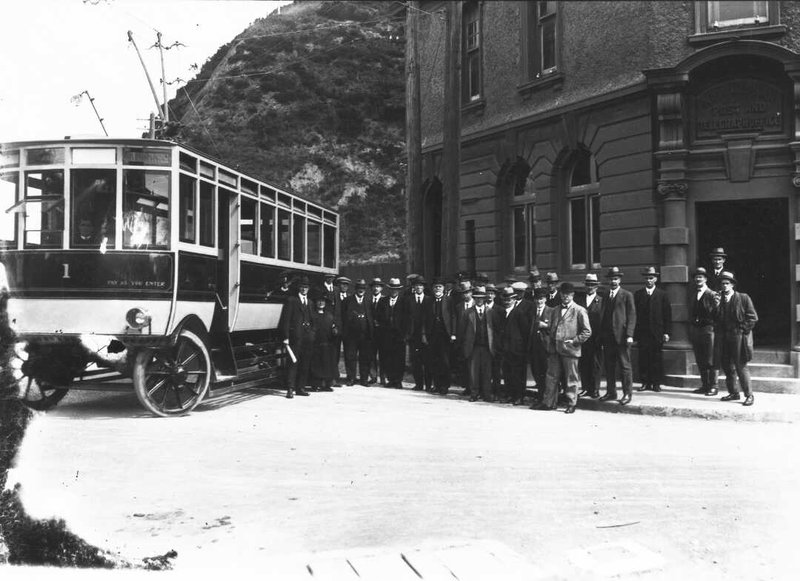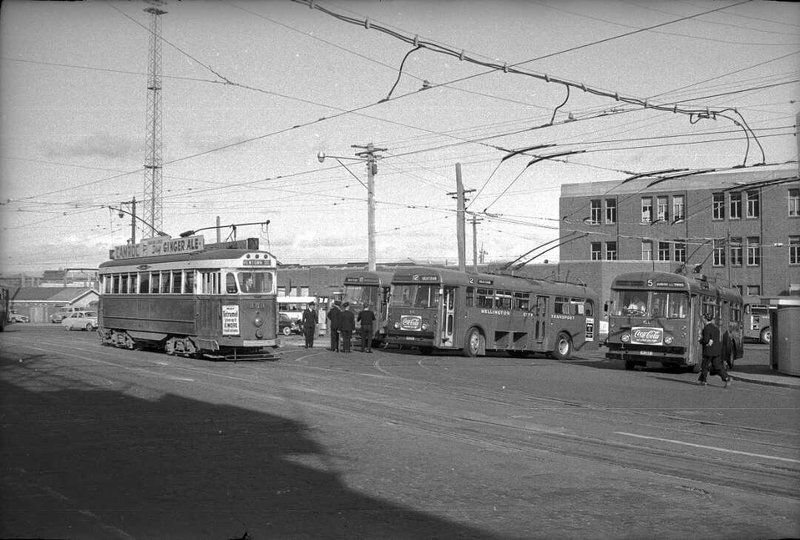Wellington's trolley buses were characteristic features of the capital city’s streets. The system's first route opened in 1924 and was expanded as the city's trams were withdrawn from service.
Original trolleybus route
The northern terminus of Wellington’s electric tram system at Thorndon car barns, opened in 1904. The first trolleybus route opened in 1924, extending the Wellington Corporation network just over a kilometre along Hutt Road to Kaiwarra (now Kaiwharawhara). There was just one “trackless tram”, which had an Auckland-built DSC and Cousins body on an AEC chassis.

First trolley bus in Wellington outside the Kaiwharawhara Post Office, 1924. Ref: 1/2-045571-G. Alexander Turnbull Library, Wellington, New Zealand. /records/23019098
The second network
In common with Auckland, New Plymouth, Dunedin and many other cities worldwide, Wellington chose trolleybuses to replace its trams after World War Two. The initial route to Roseneath, opened in 1949, continued beyond the Oriental Parade tram terminus, and was extended to Hataitai School later that year. The next route was to Aotea Quay, opened to serve the new Social Security building. It closed ten years later when that office moved, and was notable as the only trolleybus terminus in New Zealand where trolleybuses reversed to turn round.
Tram conversion started in earnest in 1951 with the opening of the route to Wadestown – the tram route had closed the previous year. Conversion of the routes continued to Karori (1954), Northland (1956), Seatoun and Miramar (1958), Aro Street and Brooklyn, the latter extended beyond the tram terminus to Mornington (1960), Lyall Bay (1963) and Island Bay (1964). New wiring ran from Waitoa Road in Hataitai to Hataitai School (1963), and the building of Wellington Airport across the Rongotai isthmus required the trolleybuses to deviate from the Coutts Street route that the trams had taken. The short Northland route closed in 1972.
After a 20-year break the Taranaki Street route to Newtown Park Zoo was wired, completing the conversion of all the tram routes except for Thorndon, followed shortly after by an extension of the Mornington route to Kingston. The system had reached its maximum length. In 1990 the pioneer Wadestown-Roseneath route closed, but the rest of the route network survives.
The buses
Until the 1980s all Wellington trolleybuses had British-built chassis: Crossley for the first 10 in 1949–50, British United Traction for the following 119 in 1951–1964. The 20-year break in route development was paralleled in vehicle purchases, and Volvo became the preferred supplier. Sixty-eight B58 chassis with Brown Boveri electrical equipment and Hawke/Coachwork International bodies were delivered in 1981–1986, together with 20 B10M chassis with Ansaldo electrical equipment and NZMB/Hess bodies second-hand from Auckland, delivered for an aborted new trolleybus system there and never used. All these are now withdrawn, equipment from the B58s re-used in the new-generation trolleys, and many of the Ansaldos converted to diesel buses, in which guise they still operate along Wellington’s streets.
Ownership
Transport deregulation in the late 1980s/early 1990s saw significant changes in ownership: Wellington City Council sold the bus operation to the Stagecoach group from Scotland, subsequently purchased by New Zealand-based Infratil, while it retained ownership of the overhead wires, now managed by its Wellington Cable Car subsidiary.
After much uncertainty about the future of the system, the 21st century saw the drastic rebuilding of the B58s into a fleet of 60 new trolleys with Designline bodies and electrics from Brazil: three two-axle prototypes and 57 three-axle production models. However, the world’s only right-hand-drive trolleybus network was phased out in 2017.

Tram and trolley buses, Wellington. Smith, Alan Eldridge, 1945- : Collection. Ref: 35mm-02148-22-F. Alexander Turnbull Library, Wellington, New Zealand. /records/22655354
More information
Location
Wellington city streets from Miramar to Karori and Wadestown.
